Good mornings are guaranteed with a warm pan of these absolutely giant cinnamon rolls. This recipe uses almost the same dough as my classic overnight cinnamon rolls, but the rolls are extra large, extra fluffy—and extra delicious! They can be made ahead of time, too, so your morning will be as easy as it is sweet. Your kitchen will smell amazing while they bake, luring even the sleepiest of sleepyheads to the breakfast table. (And that’s a fact.)
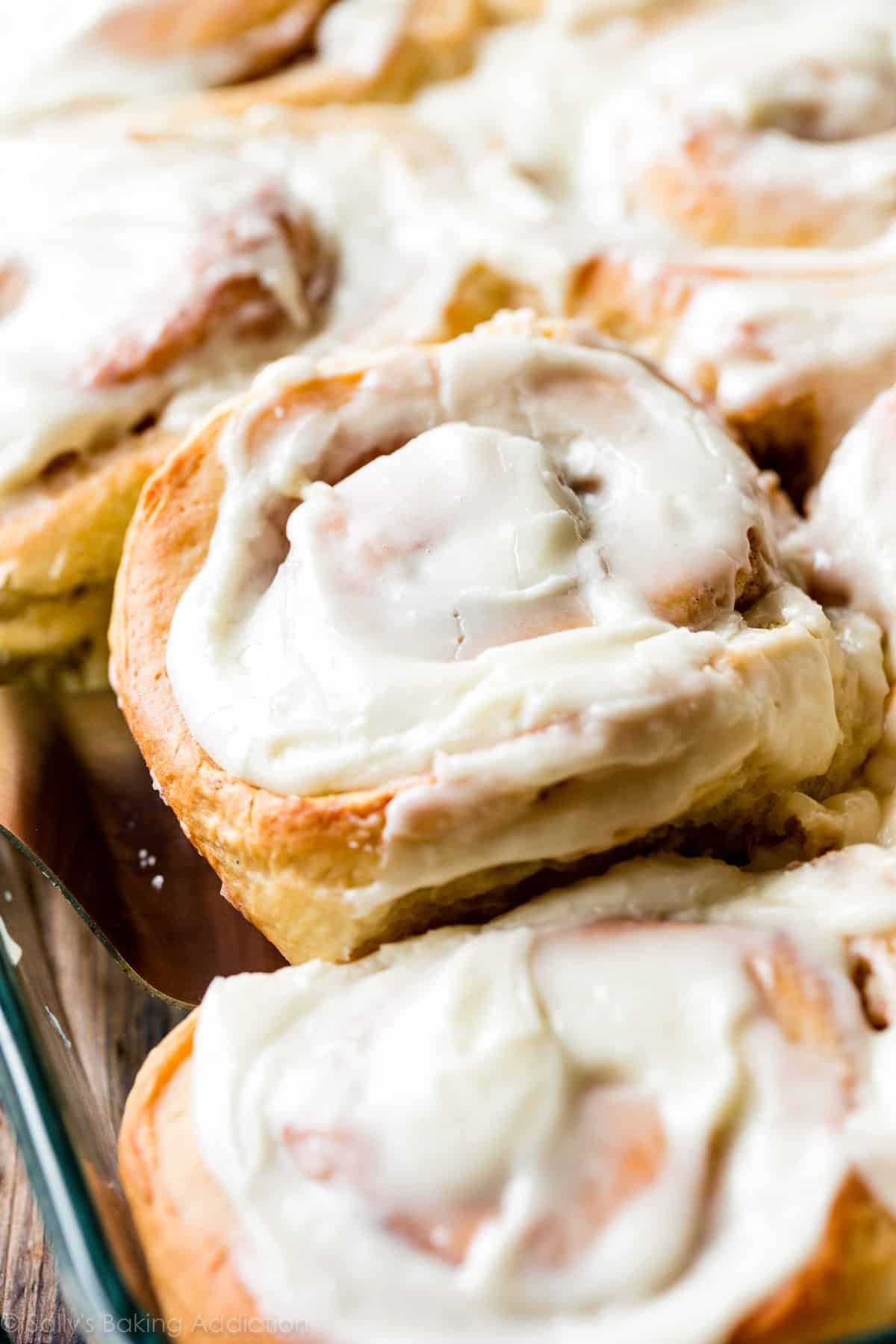
You know those oversized cinnamon rolls from bakeries, Cinnabon, and coffee shops? They’re nearly the size of your plate and maybe a little too indulgent, but who doesn’t love an extra special breakfast? I originally published this recipe in 2016, and I’m bringing it back from the archives today with new photos. The recipe hasn’t changed at all, so if you’re in the mood for an extra large, extra soft, extra over-the-top cinnamon roll, read why readers have been loving these:
“I made these cinnamon rolls last week for my family and they were amazing, everyone loved them. It was one of my first times working with yeast and so I was a little nervous but luckily this recipe was so easy to follow! They were fluffy, sweet (but not too sweet) and so tasty!” – Veronica
“I LOVE making cinnamon rolls now because of this recipe. I’ve made many recipes in the past and have never been satisfied with the results. But Sally’s Giant Cinnamon Roll recipe has people begging me to make these (and the Raspberry Swirl Rolls) all the time now. Thank you for making me love homemade rolls more than a bakery or even Cinnabon!” – Chris
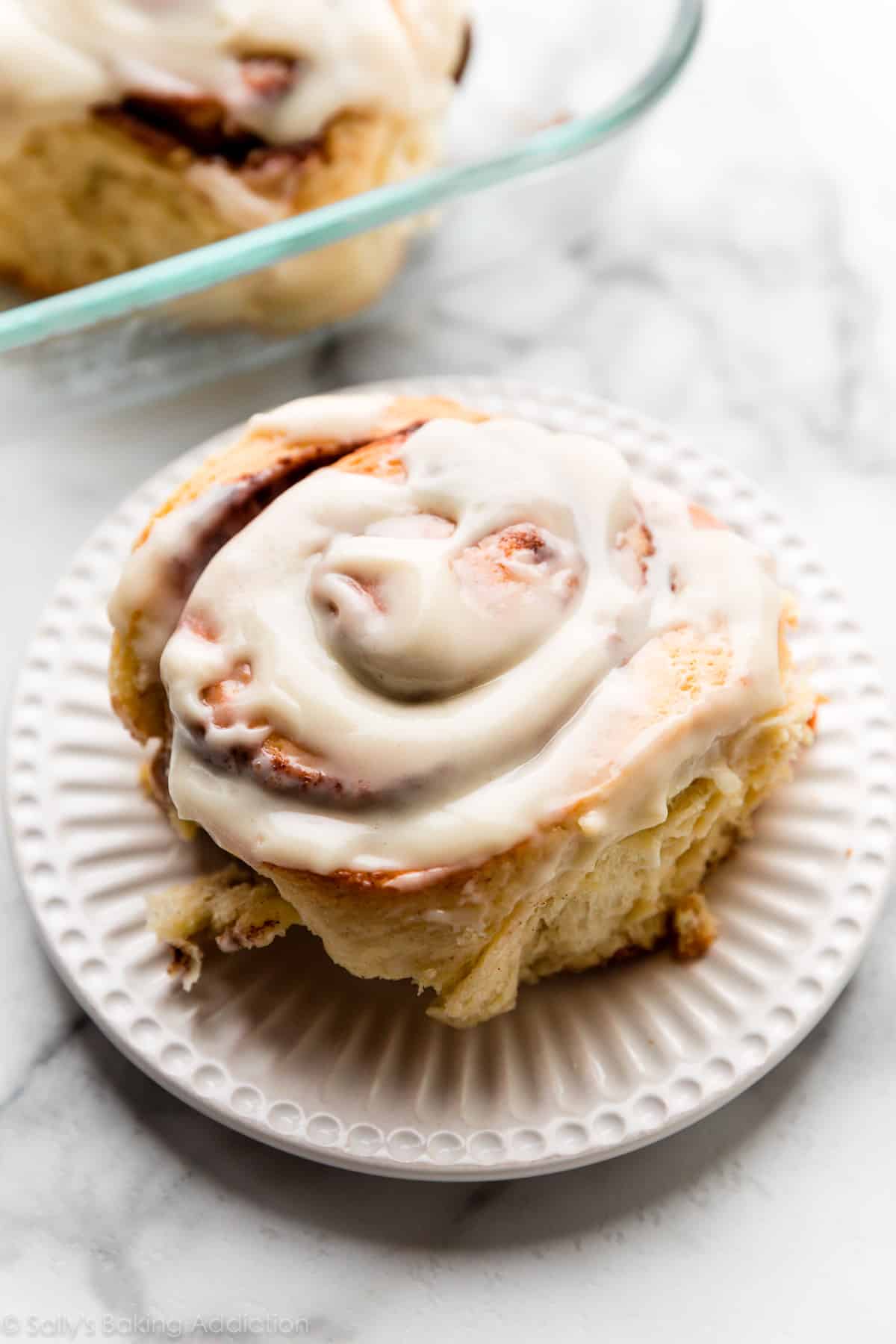
These Big Giant Cinnamon Rolls Are:
- Soft, tender, and buttery
- Packed with cinnamon-sugar-spiced scrumptiousness
- Generously slathered with cream cheese frosting
- A wonderful make-ahead recipe
- Perfect for weekend brunches or any morning occasion where you need something special
- Huge! Cinnabon size! About 3x bigger than my easy cinnamon rolls
Let’s Use My Favorite Soft Cinnamon Roll Dough
If you’ve made any of my cinnamon roll recipes before, this dough recipe will seem pretty familiar. I started with my standard sweet dough recipe that I use to make overnight cinnamon rolls, apple cinnamon rolls, and maple cinnamon rolls. It’s a rich dough, which uses butter fat to create a softer and more dessert-like bread dough. A few notable differences, though:
- Buttermilk: Buttermilk is a prime ingredient in many of my baking recipes including biscuits and vanilla cake, so I tried it in this dough. I usually use whole milk, but buttermilk makes the texture even richer and also gives the baked rolls a delicious (and very slight) tang. The buttermilk really takes these cinnamon rolls to the next level!
- Larger Rolls: I cut the rolls about 1.5x larger than I typically do. Usually this amount of dough makes 12 cinnamon rolls, but this time we’re making 8.
- Double the Yeast: We use more yeast in this recipe than in my easy cinnamon rolls. Why? Today’s big giant cinnamon rolls are much fluffier and larger—about 3x the size. After a couple hours rising, these rolls are massive and take up an entire plate. (Are you drooling yet?!)
Yeast Beginners: Use This Helpful Guide
Are you new to baking with yeast? If so, reference my Baking with Yeast Guide because I include practical answers to many common baker’s yeast questions. If you want something more, get on the fast track to baking bread like a pro with my free Beginner’s Guide to Yeast email series. 🙂
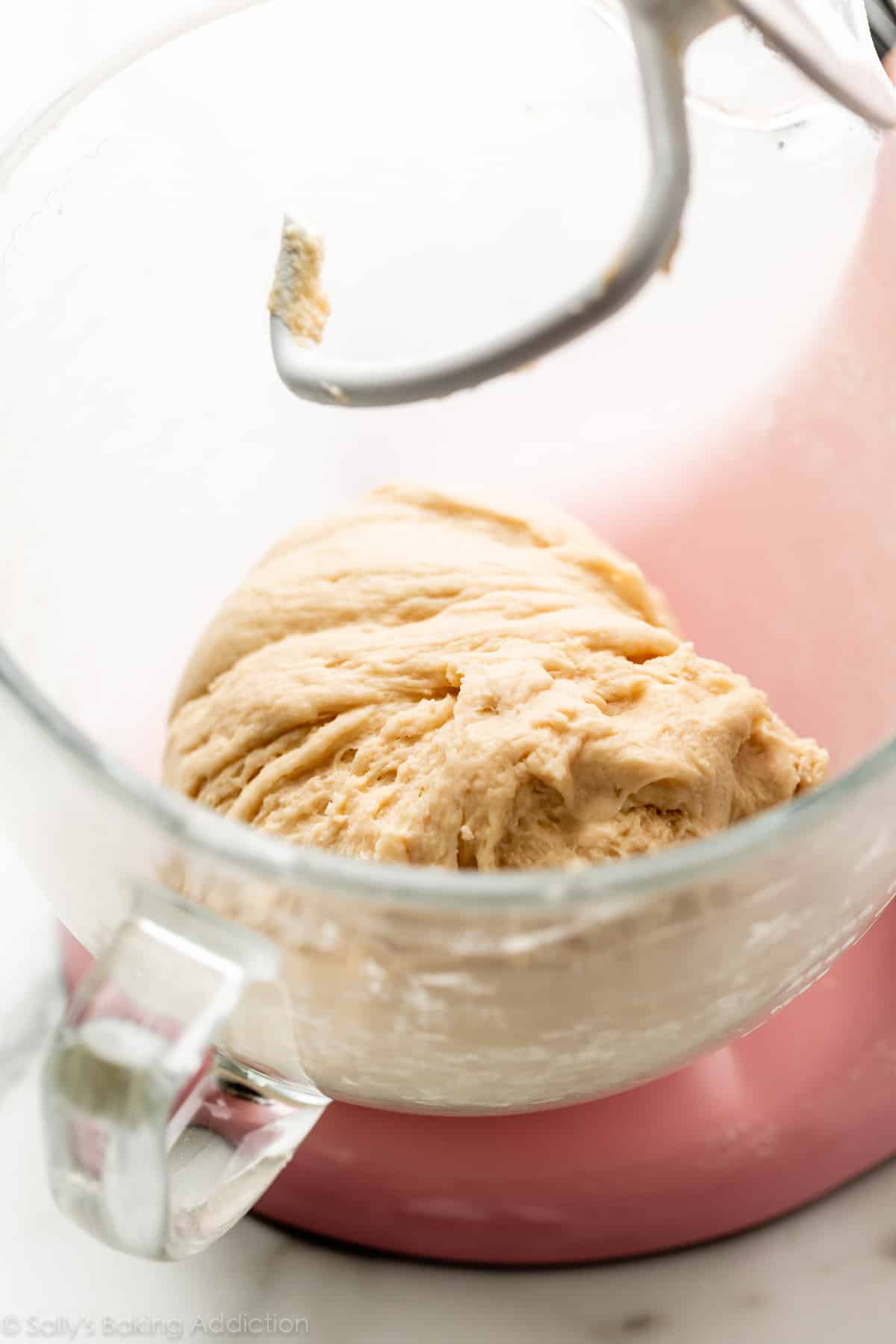
Step-by-Step Photos: How to Make Big Giant Cinnamon Rolls
Pictured above: Expect a soft and slightly sticky dough as you knead it. My How to Knead Dough video tutorial will help if you need a refresher.
Below left: This is the dough after the 1st rise. It really grows! Below right: Punch down the risen dough and get ready to roll it out and fill it.

Borrowing the following photo from overnight cinnamon rolls. Your big giant cinnamon rolls will look exactly the same as you roll up the dough with the cinnamon sugar filling inside, only you’re cutting the log into 8 cinnamon rolls instead of 12.
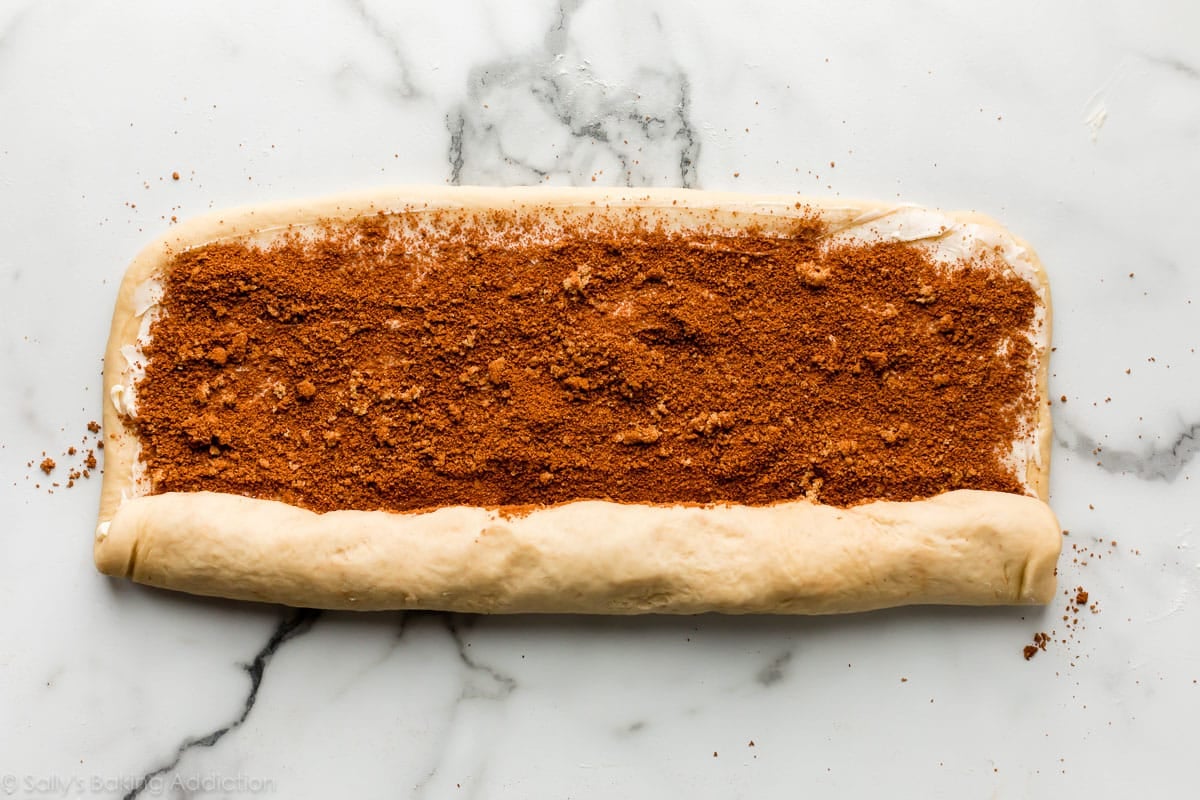
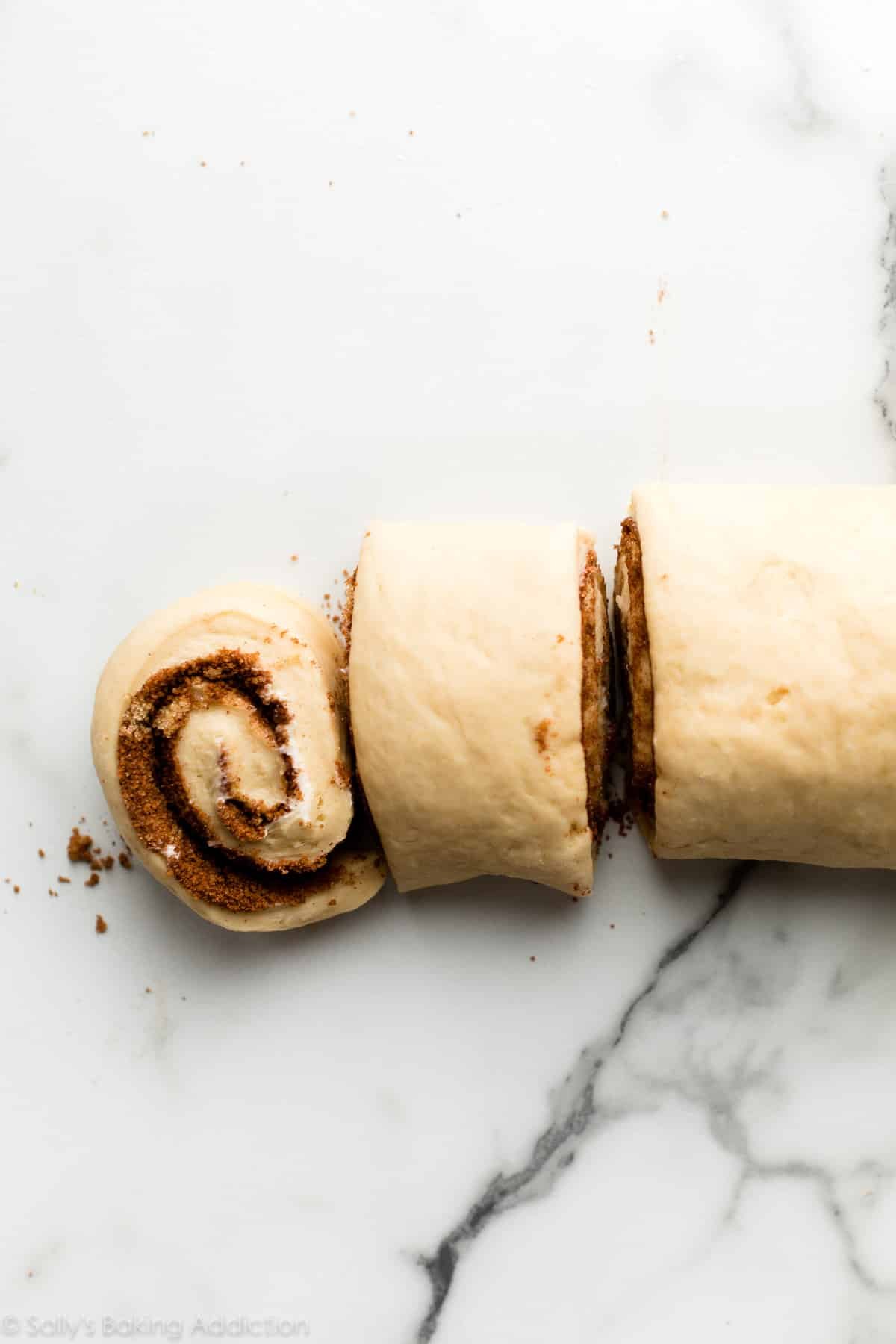
Now it’s time for the 2nd rise. After you cut all 8 rolls, place them in your greased quarter sheet pan and let them rise for about 2 hours. See how much they puff up?
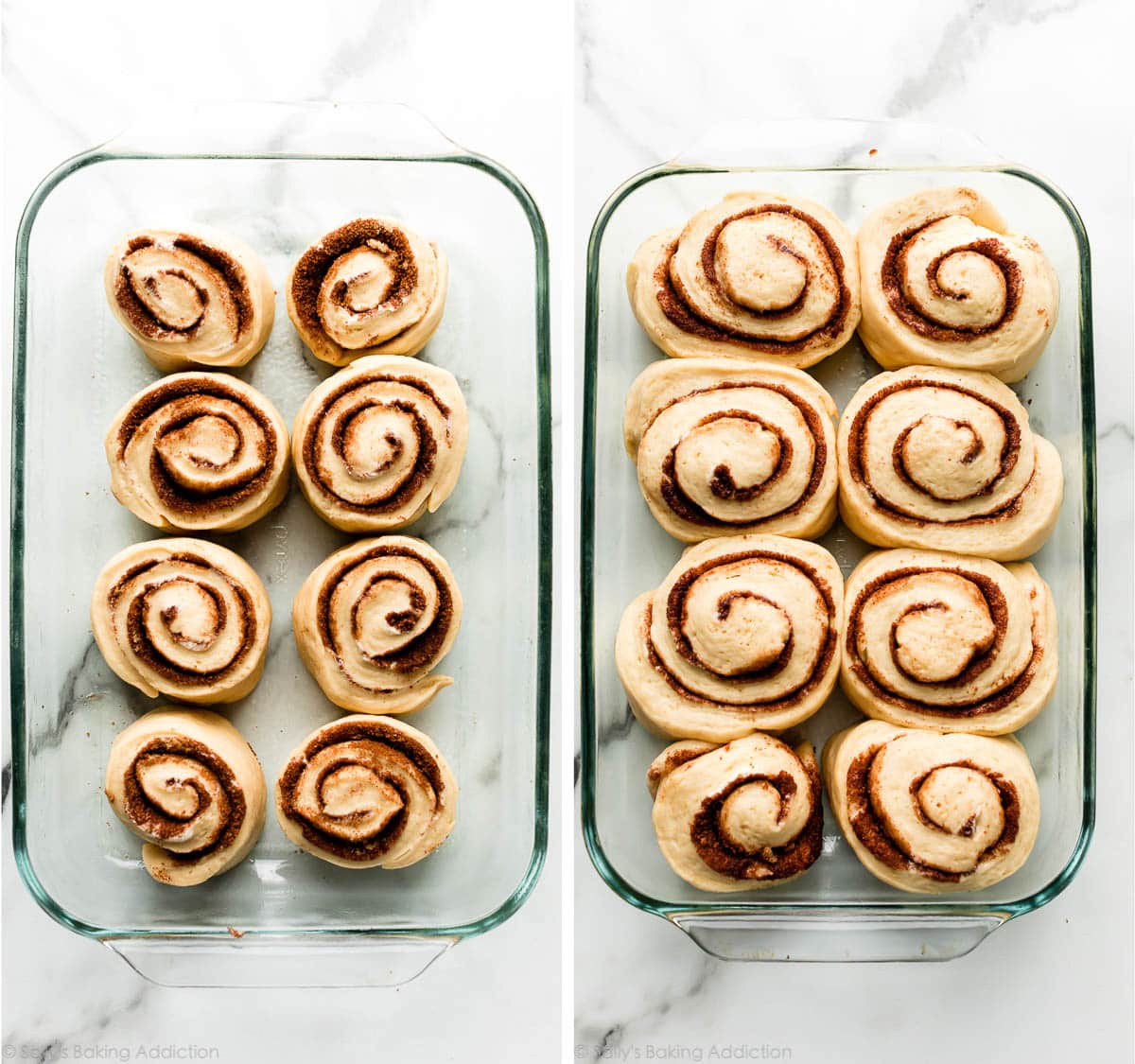
FAQ About Big Giant Cinnamon Rolls
- Can I Use Nondairy Milk? Yes, many readers have successfully substituted nondairy milks in this dough. And in a pinch, you can use 2% or 1% milk, but do not use nonfat milk.
- What If I Don’t Have a Stand Mixer? I use a stand mixer for this dough, but if you do not own a stand mixer, you can mix the dough together with a large wooden spoon/rubber spatula. It will take a bit of arm muscle. A hand mixer works, but the sticky dough repeatedly gets stuck in the beaters. Mixing by hand with a wooden spoon or rubber spatula is a better choice.
- What’s the Best Pan to Use? You need a 9×13 inch (quarter sheet) pan for this recipe. I usually use a glass 9×13-inch baking pan because I find it heats the XXL rolls more evenly than a metal pan. If metal is all you have, that’s fine, just keep a close eye on the rolls towards the end of bake time.
- Can I Switch Frostings? I top these giant cinnamon rolls with buttery cream cheese icing. If you’d like to swap toppings, try the maple icing from my maple cinnamon rolls or the vanilla icing from my easy cinnamon rolls recipe.
- Can These Rise Overnight? Yes! There are detailed overnight instructions in the recipe below.
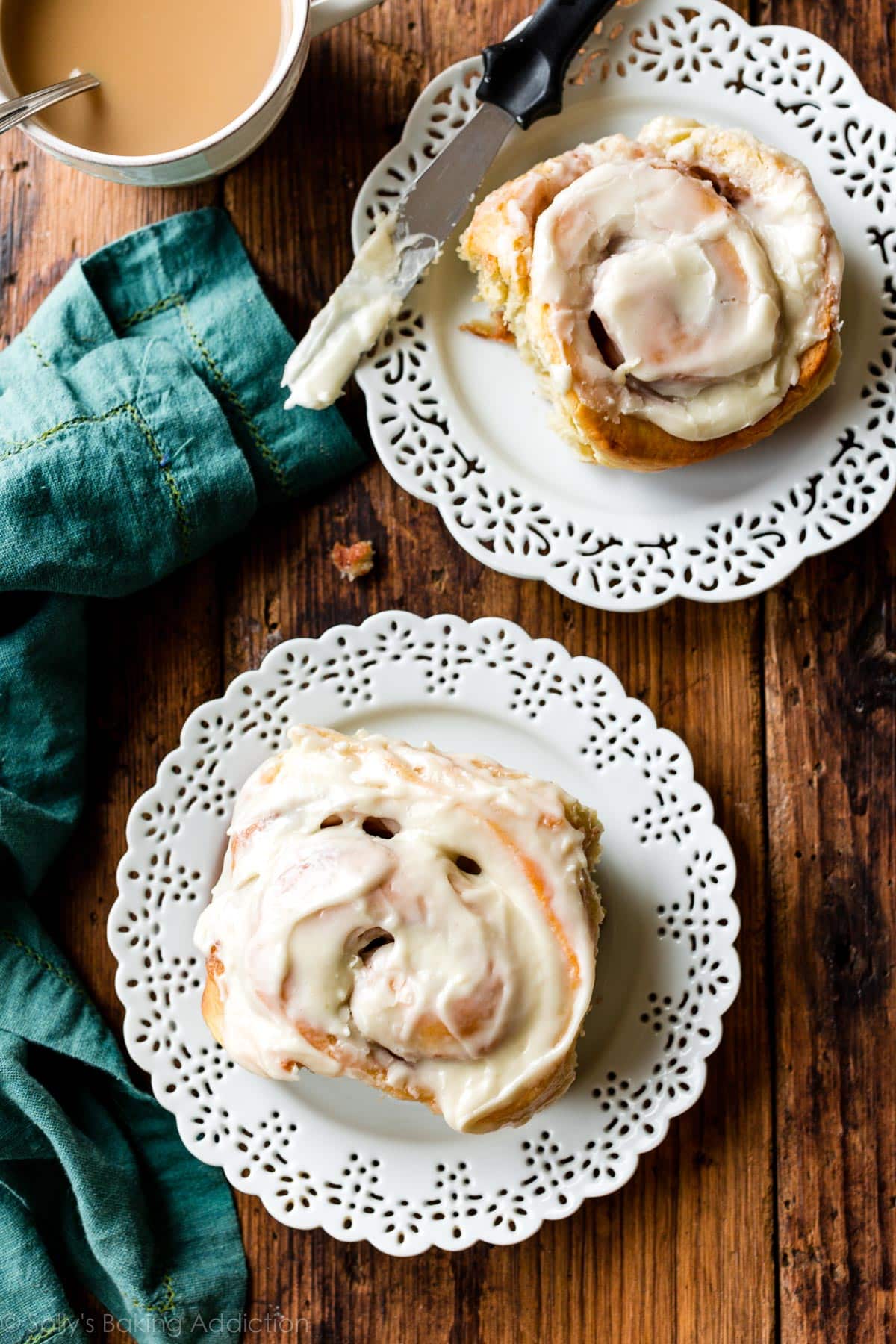
More Indulgent Breakfast Recipes
- Maple Bacon Doughnuts
- Monkey Bread
- Maple Pecan Sticky Buns
- Homemade Breakfast Pastries
- Dark Chocolate Raspberry Coffee Cake
- No Yeast Cinnamon Rolls
- Raspberry Sweet Rolls
Want something even… bigger? Here’s my giant cinnamon roll cake.
Print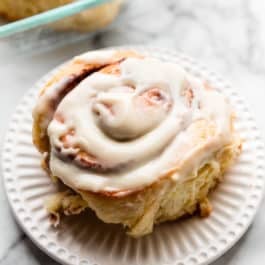
Big Giant Cinnamon Rolls
- Prep Time: 4 hours (includes rises)
- Cook Time: 25 minutes
- Total Time: 4 hours, 40 minutes (or overnight)
- Yield: 8 large rolls
- Category: Breakfast
- Method: Baking
- Cuisine: American
Description
Good mornings are guaranteed with big giant cinnamon rolls. They’re almost double the size of your typical and covered with cream cheese frosting!
Ingredients
Dough
- 1 cup (240ml) buttermilk*, warmed to about 100°F (38°C)
- 2/3 cup (135g) granulated sugar, divided
- 1 and 1/2 tablespoons (14g) active dry yeast (2 standard size packets)
- 1/2 cup (8 Tbsp; 113g) unsalted butter, softened to room temperature and cut into 4 pieces
- 2 large eggs, at room temperature
- 1/2 teaspoon salt
- 4 and 1/2 cups (563g) all-purpose flour or bread flour (spooned & leveled), plus more as needed
- 2 teaspoons canola, vegetable, or olive oil for bowl (or use nonstick spray)
Filling
- 6 Tablespoons (85g) unsalted butter, softened to room temperature
- 1/2 cup (100g) granulated sugar
- 1 and 1/2 Tablespoons ground cinnamon
Cream Cheese Icing
- 4 ounces (113g) full-fat brick cream cheese, softened to room temperature
- 1 cup (120g) confectioners’ sugar
- 1 Tablespoon (15ml) heavy cream or milk
- 1/2 teaspoon pure vanilla extract
Instructions
- Prepare the dough: Whisk the warm buttermilk, 2 Tablespoons sugar, and the yeast together in the bowl of your stand mixer fitted with a dough hook or paddle attachment. Cover and allow mixture to sit for about 5 minutes or until foamy on top. *If you do not own a mixer, you can do this in a large mixing bowl and in the next step, mix the dough together with a large wooden spoon/silicone spatula. It will take a bit of arm muscle. A hand mixer works, but the sticky dough repeatedly gets stuck in the beaters. Mixing by hand with a wooden spoon or silicone spatula is a better choice.*
- On medium speed, beat in the remaining sugar (which should be 1/2 cup/100g) and the softened butter until it is slightly broken up. Add the eggs and salt and beat on medium speed until combined. The butter won’t really be mixing into the mixture, so don’t be alarmed if it stays in pieces. Switch the mixer down to low speed and with it running, add 1 cup of flour at a time, making sure it’s fully incorporated before adding the next. After 4 cups have been added, add the last 1/2 cup and beat until the dough comes together and pulls away from the sides of the bowl, about 3 minutes. Dough will be soft.
- Knead the dough: Keep the dough in the mixer and beat for an additional 5 full minutes, or knead by hand on a lightly floured surface for 5 full minutes. (If you’re new to bread-baking, my How to Knead Dough video tutorial can help here.) If the dough becomes too sticky during the kneading process, sprinkle 1 teaspoon of flour at a time on the dough or on the work surface/in the bowl to make a soft, slightly tacky dough. Do not add more flour than you need because you do not want a dry dough. After kneading, the dough should still feel a little soft. Poke it with your finger—if it slowly bounces back, your dough is ready to rise. You can also do a “windowpane test” to see if your dough has been kneaded long enough: tear off a small (roughly golfball-size) piece of dough and gently stretch it out until it’s thin enough for light to pass through it. Hold it up to a window or light. Does light pass through the stretched dough without the dough tearing first? If so, your dough has been kneaded long enough and is ready to rise. If not, keep kneading until it passes the windowpane test.
- 1st Rise: Lightly grease a large bowl with oil or use nonstick spray. Place the dough in the bowl, turning it to coat all sides in the oil. Cover the bowl with aluminum foil, plastic wrap, or a clean kitchen towel. Allow the dough to rise in a relatively warm environment for 2 hours or until double in size. (I always let it rise on the counter and it takes about 2 hours. For a tiny reduction in rise time, see my answer to Where Should Dough Rise? in my Baking with Yeast Guide.)
- Grease the bottom and sides of a metal or glass 9×13-inch baking dish or line with parchment paper.
- Roll out the dough: Punch down the dough to release the air. Turn the dough out onto a lightly floured work surface and, using a rolling pin, roll into a 10×16-inch rectangle. Make sure the dough is smooth and evenly thick. If the dough keeps shrinking as you roll it out, stop what you’re doing, cover it lightly, and let it rest for 10 minutes to relax the gluten. When you return to the dough, it should stretch out much easier.
- For the filling: Spread the softened butter all over the dough. In a small bowl, toss the cinnamon and sugar together until combined and then sprinkle evenly over the dough. Tightly roll up the dough to form a 16 inch long log. If some filling spills out, that’s ok just sprinkle it on top of the rolls. Cut into 8 large rolls (about 2 inches in width each). Arrange them in the prepared baking pan.
- 2nd Rise: Cover the rolls tightly and allow to rise until puffy, about 2 hours. (Or use the overnight option in the Notes below.)
- Preheat the oven to 375°F (191°C).
- Bake for about 25 minutes or until they are lightly browned on top. About halfway through baking time, tent a piece of aluminum foil over the pan to prevent the tops from browning too quickly. Remove pan from the oven and allow to cool on a wire rack for about 10 minutes as you make the icing.
- Make the icing: In a medium bowl using a handheld or stand mixer fitted with a paddle or whisk attachment, beat the cream cheese on medium speed until smooth and creamy. Add the confectioners’ sugar, cream/milk, and vanilla. Beat on low speed for 30 seconds, then switch to high speed and beat for 1 minute. Spread the icing over the warm rolls and serve immediately.
- Cover leftover frosted or unfrosted rolls tightly and store at room temperature for 2 days or refrigerator for 5 days.
Notes
- Make Ahead Instructions – Overnight: To prepare the night before serving, prepare the rolls through step 7. Cover the rolls tightly and refrigerate for 8–12 hours. The next morning, remove from the refrigerator and allow to rise on the counter for 1–2 hours before continuing with step 9.
- Make Ahead Instructions – Freezing: Baked rolls can be frozen up to 2–3 months. Thaw overnight in the refrigerator and warm up before enjoying. You can also freeze the unbaked rolls and here’s how: Bake the rolls in step 9 for only about 10 minutes at 375°F (191°C). Cool completely, then cover tightly and freeze. To serve, take the rolls out of the freezer and put into the refrigerator a few hours before serving. Then, finish baking them for 15–20 minutes right before serving.
- Special Tools (affiliate links): Stand Mixer | Rolling Pin | 9×13-Inch Glass Baking Pan or Metal Baking Pan | Glass Mixing Bowls
- Milk: Buttermilk adds delicious richness and tang to this dough. If needed, you can use whole milk instead. (I usually use one or the other.) You can use lower fat or nondairy milk in a pinch, but the rolls won’t taste nearly as moist or rich.
- Reference my Baking with Yeast Guide for answers to common yeast FAQs.



















Hi Sally! I bake for a coffee shop, and I use your cinnamon roll recipe. The customers can’t get enough! Love your site.
I loved your recipe but if i double the recipe will i be able to get big enough rolls for a bigger sized pan?
Hi Lorene, for best results, we recommend making two separate batches rather than doubling.
I love this recipe! Can I refrigerate dough over night before prepping rolls, like stop the process at step 4 and have the dough rise overnight?
Hi Jenni, you can, but it’s really best to have the second rise be the longer overnight rise in the refrigerator. Glad to hear this is a favorite for you!
This recipe was AMAZING !!! It’s a keeper for sure!
Perfect amount of rolls and frosting, turns out amazing every time ❤️
I was asked by my family to try another cinnamon roll recipe, so I made these rolls for Christmas Day- they were a Huge success! They look dense but are light! And with the cream cheese frosting they’re so good! This is my new Christmas tradition! Thank you Sally!
This is a follow up to my original glowing review…I almost burned them on the bottom. Would it be better to reduce the temperature or reduce the time in the oven? Thanks!
Hi Shelly, are you using a metal pan? If you have one available to you, an oven-safe glass pan may work better for you. You can also try moving the rolls up/down a rack, away from the heating element, or reducing the time or temperature. If you reduce the temperature, it will take a bit longer to bake through. We’re so glad you enjoyed the rolls!
I served these on Christmas morning and they were wonderful! Some of the comments were “This is the best cinnamon roll I’ve ever had!” And “You should sell these, I would buy them!” The leftovers reheated beautifully. I made extra frosting so that there would be plenty. I added a lot more cream than the recipe called for so that it would be easy to spread. I used a stand mixer and they were simple to make. Highly recommend!
I usually make Sally’s easy cinnamon rolls recipe for Christmas morning, but decided to try this one instead this year. So glad I did!! I used whole milk instead of buttermilk and bread flour instead of all purpose. They rose beautifully (I did the overnight option) but did need longer than 25 minutes to bake. They were light, pillowy soft and incredibly delicious!
These sound fantastic and I can’t wait to make them! If I wanted to make orange cream cheese frosting, how much juice/zest would you recommend?
Hi Stephanie, you could try replacing some of the heavy cream/milk with orange juice, and then adding the zest from 1 orange to the frosting. Feel free to tinker with the amounts based on your flavor preferences. Hope you enjoy the rolls!
Can they be cut smaller to make 12 roll?
Hi Julie, Here’s our recipe for 12 regular cinnamon rolls. Enjoy!
Haven’t made them yet, but..can I use my bread machine?
Hi Becky, We haven’t tested this dough in a bread machine but let us know how it goes if you do!
I have used a bread machine to make the dough – it makes it beautifully. Just need to let it rise longer than the actual time the machine lets its proof. I have a Zojirushi PAC 20 and I follow the directions er the manufactur on how to put the ingredients in the machine. Saves me time and the recipe is delish! getting ready to put a batch in the oven now!
My (still) glowing review of the recipe and its outcome has become tarnished by the inferior experience of this website which is constantly loading ads and falling off the internet. Type sentences into the ether and then wait for them to show up. Thank God I can print the recipe and be done with it.
One suggestion: Group the ingredients as used, not all the sugar in the first group and then having the instructions tell you only to use 2T of the listed amount. Also, the overnite suggestion (which I didn’t use) doesn’t really save time or effort.
Perfect! Nice big buns with a solid bread/roll like texture and a minimum of the hard, dry, baked on crust. Just what I was looking for. Nice clear instructions, easy to make
This is why Sally’s is one of my go-to recipe websites.
. And yes, your mother gives you permission to change the ingredients as long as you take responsibility if things go south.
The 375 is too high, burnt the bottom of my rolls that were on parchment paper in a glass dish. I am so disappointed, all that time, had to keep them rather than giving to my employees at work.
Can you use buttermilk substitute using whole milk and vinegar if you don’t have store-bough buttermilk?
Hi Melissa! See recipe notes. Whole milk will work too, or you can make your own buttermilk substitute if desired.
Thank you for the recipe. I love to bake all kinds of breads and with Christmas coming these are my gifts!
In this recipe it says use granulated sugar and cinnamon but the recipe for regular cinnamon rolls uses brown sugar and cinnamon.
Whats the difference or is this a typo?
You can really use either! They’re delicious either way. Hope you enjoy!
My dough was flaky and tasted more like a biscuit. What did I do wrong? It was delicious just not quite what I expected.
Hi Alisha, we’re happy to help troubleshoot. How did you measure your flour? Be sure to spoon and level (or use a kitchen scale) to ensure the flour isn’t over measured, which can dry out the rolls and make them take on more of a biscuit texture. Be cautious not to over knead the dough, as that can cause to to become tough. Hope this helps for next time!
Delicious! I’ve made this particular recipe twice now (and your other cinnamon rolls several times!) and they seem to take quite a bit longer to bake than the 25 minutes recommended. I made the dough the day before and let rest on the counter for over an hour before baking in the morning. Just make sure to allow enough time for baking if doing this method. Nonetheless… DELICIOUS!
Tried making two times, dough never came together
I add brown sugar to the granulated sugar and cinnamon filling. Once you try it this way, you will most likely continue to do so.
I let the rolls stay in fridge overnight. They are puffy! Do i let them rise more or can I bake them cold from the fridge?
Hi Nicole, if they have doubled in size, you can remove them from the refrigerator and allow them to sit at room temperature while your oven preheats, then bake. Enjoy!
Can I use Monk Fruit in place of sugar
Can I use bread flour instead of AP
Hi AnnMarie, Bread flour should work for chewier rolls. Enjoy!
Hi AnnMarie, We’d love to help but we are not trained in baking with sugar substitutes. For best taste and texture (and so you don’t waste your time trying to adapt this recipe since it may not work properly), it may be more useful to find a recipe that is specifically formulated for sugar substitutes.
Monk fruit sugar can ALWAYS be a replacement for sugar, it has the same texture and properties. The only thing that will change is the taste.